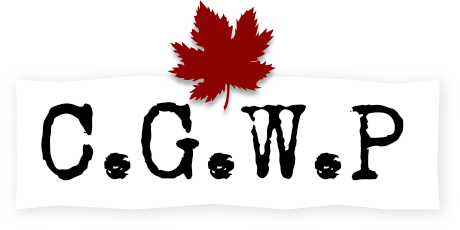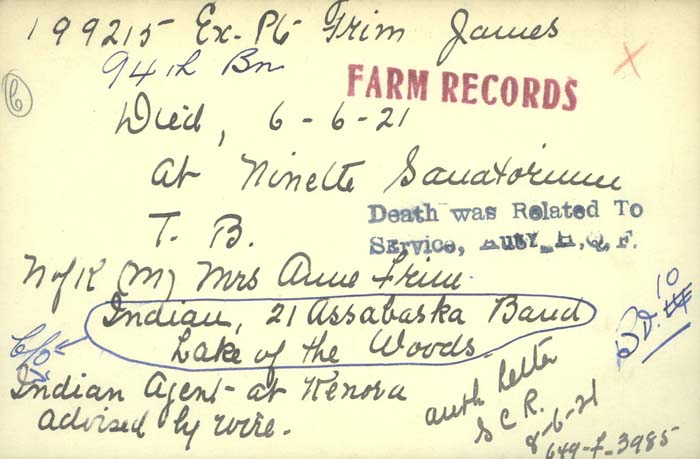
Private James Frim
PERSONAL INFORMATION
MILITARY INFORMATION
- Private, 28th Battalion, Infantry (Army).
- Private (Army).
- Private (Army).
Images
RESEARCH INFORMATION
Private James Frim enlisted in Dryden, Ontario in the spring of 1916 and served in France for ten months before becoming seriously ill. He was invalided back to Canada and he passed away in June 1921.
James was born around 1888 in Lac Seul, northern Ontario, the son of Annie Frim and Sha-boo-keejick-oh-kai. Annie was from Eagle Lake Reserve, about 80 km southwest of Lac Seul, and her husband was from Big Grassy Reserve (Assabaska) on Lake of the Woods. Later as a widow Annie was also known as Mrs. Wawayance.
The war started in August 1914 and James enlisted on 28 March 1916 in Dryden, Ontario. He was about 27 years old, working as a hunter and trapper at the time and living at Eagle Lake Reserve. He joined the 94th Battalion, which had been organized in November 1915 in Port Arthur and was being recruited throughout northwestern Ontario. After training over the winter the men were sent to Port Arthur at the end of May to join the rest of the battalion. On 9 June 1916 they left by train for the east coast. They spent a short time at Valcartier, a large military camp northwest of Quebec City, before embarking from Halifax on 28 June aboard the SS Olympic. In England the recruits were absorbed into reserve battalions to be used as reinforcements for other units.
James was transferred to the 17th Reserve Battalion in July 1916. After six more weeks of training he was drafted to the 28th (North-West) Battalion and sent to France. He spent some time at the Base Depot before joining his new unit in the field at the end of September, in a draft of 70 reinforcements. The 28th had just been through a successful assault near Courcelette (15-22 September 1916), part of the Battle of the Somme. The battalion took part in further operations in the area in October. The Somme Offensive ended on 18 November and in 2-1/2 months there the Canadian Corps suffered 24,000 casualties.
In December 1916 James spent several weeks in hospital, suffering from a fever, and he rejoined his unit on Christmas Day. In the early months of 1917 the 28th Battalion was in the Lens area in France, opposite Vimy, and they had the usual rotations in the front trenches. Plans were underway for the attack on Vimy Ridge, set to start in early April, and the Canadian units were undergoing intensive training. The assault began on Easter Monday morning, 9 April, and it was a remarkable success, the first time all four Canadian Divisions were used in one operation.The 28th Battalion took part in the main attack on the opening day and they remained in the area until the end of May when they were moved north to Haillicourt.
From the War Diary of the 28th Battalion, 30 June 1917,"During the month ending June 30th 1917, the Battalion has been rested and reorganized at Haillicourt. Reinforcements have been received in both Officers and O.R., and aided by exceptionally fine weather, except during the last few days of the month, the Battalion has reached a good standard in Training, Discipline and Appearance. The health of the men has improved considerably. The behaviour of the men in the village of Haillicourt has been excellent. In every way the rest has been a great help to the Battalion after 2 months of heavy fighting since April 9th 1917."
In July 1917 James became ill again and he was admitted to No. 10 British General Hospital in Rouen, France. After an operation there he was sent back to the UK where he was diagnosed with pulmonary tuberculosis. Over the next nine months he was treated at four different hospitals in England, then he was invalided to Canada for further treatment, arriving on 20 May 1918 on the hospital ship Llandovery Castle. (One month later, on 27 June 1918, the Germans torpedoed the Llandovery Castle off the coast of Ireland with the loss of 234 lives, including 14 nursing sisters.) After arriving in Canada James was sent to the Manitoba Sanatorium in Ninette, Manitoba: Sanatorium
James was admitted to the Sanatorium in June 1918. On his doctor's recommendation he was discharged from the army on 19 August and transferred to the Invalided Soldiers Commission. He had further treatment for his TB at St. Joseph's Hospital in Port Arthur, Ontario between June 1919 and January 1920. When he left the hospital his TB was said to be arrested with no need for further treatment. Sometime in the next 18 months he became ill enough to be admitted to the Manitoba Sanatorium again and he died there on 6 June 1921.
James' body was returned to Kenora and interred in Lake of the Woods Cemetery. Although he died in Manitoba his death was registered in the District of Kenora, Ontario. He is on a list of people who died at the Sanatorium in Ninette but are buried somewhere else (see bottom of page here).
James is commemorated on the Kenora Cenotaph, the Kenora Legion War Memorial, the Anishinaabe Veteran Heroes plaque at the Ne-Chee Friendship Centre in Kenora (as Jim Flim), and the Aboriginal Veterans Tribute page here. At the time of his death his mother's address was Assabaska Reserve (Big Grassy) on Lake of the Woods. She passed away two years later, on 14 July 1923, at St. Joseph's Hospital in Kenora and she's also buried in Lake of the Woods Cemetery.
On James' Attestation Paper his birth date is "Aug -- 1888." In his service records it's listed as 15 June 1889, August 1890 and August 1891. There are also several different spellings of his surname in his service records: Frim, Frimm, Flim and Flinn.
James is listed as Jim Flim on the Aboriginal Veterans Tribute page here.
"The Story of the 28th Battalion - 1914-1917" by G.E. Hewitt: 28thBn
